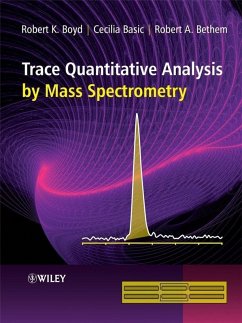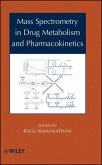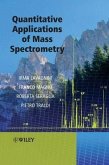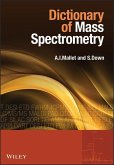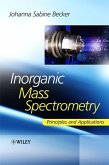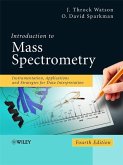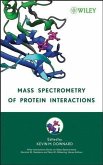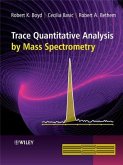Robert K. Boyd, Cecilia Basic, Robert A. Bethem
Trace Quantitative Analysis by Mass Spectrometry (eBook, PDF)
102,99 €
102,99 €
inkl. MwSt.
Sofort per Download lieferbar

0 °P sammeln
102,99 €
Als Download kaufen

102,99 €
inkl. MwSt.
Sofort per Download lieferbar

0 °P sammeln
Jetzt verschenken
Alle Infos zum eBook verschenken
102,99 €
inkl. MwSt.
Sofort per Download lieferbar
Alle Infos zum eBook verschenken

0 °P sammeln
Robert K. Boyd, Cecilia Basic, Robert A. Bethem
Trace Quantitative Analysis by Mass Spectrometry (eBook, PDF)
- Format: PDF
- Merkliste
- Auf die Merkliste
- Bewerten Bewerten
- Teilen
- Produkt teilen
- Produkterinnerung
- Produkterinnerung

Bitte loggen Sie sich zunächst in Ihr Kundenkonto ein oder registrieren Sie sich bei
bücher.de, um das eBook-Abo tolino select nutzen zu können.
Hier können Sie sich einloggen
Hier können Sie sich einloggen
Sie sind bereits eingeloggt. Klicken Sie auf 2. tolino select Abo, um fortzufahren.

Bitte loggen Sie sich zunächst in Ihr Kundenkonto ein oder registrieren Sie sich bei bücher.de, um das eBook-Abo tolino select nutzen zu können.
This book provides a serious introduction to the subject of mass spectrometry, providing the reader with the tools and information to be well prepared to perform such demanding work in a real-life laboratory. This essential tool bridges several subjects and many disciplines including pharmaceutical, environmental and biomedical analysis that are utilizing mass spectrometry: * Covers all aspects of the use of mass spectrometry for quantitation purposes * Written in textbook style to facilitate understanding of this topic * Presents fundamentals and real-world examples in a 'learning-though-doing' style…mehr
- Geräte: PC
- mit Kopierschutz
- eBook Hilfe
- Größe: 13.97MB
Andere Kunden interessierten sich auch für
![Mass Spectrometry in Drug Metabolism and Pharmacokinetics (eBook, PDF) Mass Spectrometry in Drug Metabolism and Pharmacokinetics (eBook, PDF)]() Mass Spectrometry in Drug Metabolism and Pharmacokinetics (eBook, PDF)112,99 €
Mass Spectrometry in Drug Metabolism and Pharmacokinetics (eBook, PDF)112,99 €![Quantitative Applications of Mass Spectrometry (eBook, PDF) Quantitative Applications of Mass Spectrometry (eBook, PDF)]() Pietro TraldiQuantitative Applications of Mass Spectrometry (eBook, PDF)45,99 €
Pietro TraldiQuantitative Applications of Mass Spectrometry (eBook, PDF)45,99 €![Dictionary of Mass Spectrometry (eBook, PDF) Dictionary of Mass Spectrometry (eBook, PDF)]() Anthony I. MalletDictionary of Mass Spectrometry (eBook, PDF)45,99 €
Anthony I. MalletDictionary of Mass Spectrometry (eBook, PDF)45,99 €![Inorganic Mass Spectrometry (eBook, PDF) Inorganic Mass Spectrometry (eBook, PDF)]() Sabine BeckerInorganic Mass Spectrometry (eBook, PDF)178,99 €
Sabine BeckerInorganic Mass Spectrometry (eBook, PDF)178,99 €![Introduction to Mass Spectrometry (eBook, PDF) Introduction to Mass Spectrometry (eBook, PDF)]() J. Throck WatsonIntroduction to Mass Spectrometry (eBook, PDF)100,99 €
J. Throck WatsonIntroduction to Mass Spectrometry (eBook, PDF)100,99 €![Mass Spectrometry of Protein Interactions (eBook, PDF) Mass Spectrometry of Protein Interactions (eBook, PDF)]() Mass Spectrometry of Protein Interactions (eBook, PDF)85,99 €
Mass Spectrometry of Protein Interactions (eBook, PDF)85,99 €![Trace Quantitative Analysis by Mass Spectrometry (eBook, ePUB) Trace Quantitative Analysis by Mass Spectrometry (eBook, ePUB)]() Robert K. BoydTrace Quantitative Analysis by Mass Spectrometry (eBook, ePUB)102,99 €
Robert K. BoydTrace Quantitative Analysis by Mass Spectrometry (eBook, ePUB)102,99 €-
-
-
This book provides a serious introduction to the subject of mass spectrometry, providing the reader with the tools and information to be well prepared to perform such demanding work in a real-life laboratory. This essential tool bridges several subjects and many disciplines including pharmaceutical, environmental and biomedical analysis that are utilizing mass spectrometry: * Covers all aspects of the use of mass spectrometry for quantitation purposes * Written in textbook style to facilitate understanding of this topic * Presents fundamentals and real-world examples in a 'learning-though-doing' style
Dieser Download kann aus rechtlichen Gründen nur mit Rechnungsadresse in D ausgeliefert werden.
Produktdetails
- Produktdetails
- Verlag: John Wiley & Sons
- Erscheinungstermin: 2. August 2008
- Englisch
- ISBN-13: 9780470727157
- Artikelnr.: 37299189
- Verlag: John Wiley & Sons
- Erscheinungstermin: 2. August 2008
- Englisch
- ISBN-13: 9780470727157
- Artikelnr.: 37299189
- Herstellerkennzeichnung Die Herstellerinformationen sind derzeit nicht verfügbar.
Professor Robert K Boyd, National Research Council, Institute for National Measurement Standards, Ottawa, Canada
Robert Boyd obtained his B Sc and Ph D from St Andrews University. In 1962 he took a post-doctoral fellow position at NRC followed by periods at the University of Toronto & University of Guelph. In 1986 he re-joined the NRC, and since that time has served as adjunct professor at Dalhousie University (1992-2001). Since 2001 he has been Researcher Emeritus at the NRC in Ottawa.
Professor Boyd has published over 160 research papers, four book chapters & 10 NRC Technical reports. In 1002 he received the Maxxam Award for Analytical Chemistry and in 2003 the Queen Elizabeth II Gold Jubilee Medal. He is currently Chair of the Science Advisory Board for the Genome Prarie project on enabling technologies for proteomics. And a member of the NSERC Committee for Scientific & Technical review of ISTC proposals. He was an editor for Rapid Communications in Mass Spectrometry from 1990 - 1997 and from 1997 - 2005 was the journal's Editor-in-Chief.
Dr Robert A Bethem, senior VP of the Bioanalytical Group at Alta Analytical Laboratory, CA, USA and Professor Dwight Matthews of the University of Vermont, USA
Robert Boyd obtained his B Sc and Ph D from St Andrews University. In 1962 he took a post-doctoral fellow position at NRC followed by periods at the University of Toronto & University of Guelph. In 1986 he re-joined the NRC, and since that time has served as adjunct professor at Dalhousie University (1992-2001). Since 2001 he has been Researcher Emeritus at the NRC in Ottawa.
Professor Boyd has published over 160 research papers, four book chapters & 10 NRC Technical reports. In 1002 he received the Maxxam Award for Analytical Chemistry and in 2003 the Queen Elizabeth II Gold Jubilee Medal. He is currently Chair of the Science Advisory Board for the Genome Prarie project on enabling technologies for proteomics. And a member of the NSERC Committee for Scientific & Technical review of ISTC proposals. He was an editor for Rapid Communications in Mass Spectrometry from 1990 - 1997 and from 1997 - 2005 was the journal's Editor-in-Chief.
Dr Robert A Bethem, senior VP of the Bioanalytical Group at Alta Analytical Laboratory, CA, USA and Professor Dwight Matthews of the University of Vermont, USA
Preface.
Acknowledgements.
1 Measurement, Dimensions and Units.
1.1 Introduction.
1.2 The International System of Units (SI).
1.3 'Mass-to-Charge Ratio' in Mass Spectrometry.
1.4 Achievable Precision in Measurement of SI Base Quantities.
1.5 Molecular Mass Limit for Trace Quantitation by Mass Spectrometry.
1.6 Summary of Key Concepts.
2 Tools of the Trade I. The Classical Tools.
2.1 Introduction.
2.2 Analytical and Internal Standards: Reference Materials.
2.3 The Analytical Balance.
2.4 Measurement and Dispensing of Volume.
2.5 Preparation of Solutions for Calibration.
2.6 Introduction to Calibration Methods for Quantitative Analysis.
2.7 Summary of Key Concepts.
3 Tools of the Trade II. Theory of Chromatography.
3.1 Introduction.
3.2 General Principles of Chemical Separations.
3.3 Summary of Important Concepts.
3.4 Plate Theory of Chromatography.
3.5 Nonequilibrium Effects in Chromatography: the van Deemter Equation.
3.6 Gradient Elution.
3.7 Capillary Electrophoresis and Capillary Electrochromatography.
Appendix 3.1 Derivation of the Plate Theory Equation for Chromatographic
Elution.
Appendix 3.2 Transformation of the Plate Theory Elution Equation from
Poisson to Gaussian Form.
Appendix 3.3 A Brief Introduction to Snyder's Theory of Gradient Elution.
List of Symbols Used in Chapter 3.
4 Tools of the Trade III. Separation Practicalities.
4.1 Introduction.
4.2 The Analyte and the Matrix.
4.3 Extraction and Clean-Up: Sample Preparation Methods.
4.4 Chromatographic Practicalities.
4.5 Summary of Key Concepts.
Appendix 4.1 Responses of Chromatographic Detectors: Concentration vs
Mass-Flux Dependence.
5 Tools of the Trade IV. Interfaces and Ion Sources for Chromatography-Mass
Spectrometry.
5.1 Introduction.
5.2 Ion Sources that can Require a Discrete Interface Between Chromatograph
and Source.
5.3 Ion Sources not Requiring a Discrete Interface.
5.4 Source-Analyzer Interfaces Based on Ion Mobility.
5.5 Summary of Key Concepts.
5.1 Appendix 5.1: Methods of Sample Preparation for Analysis by MALDI.
6 Tools of the Trade V. Mass Analyzers for Quantitation: Separation of Ions
by m/z Values.
6.1 Introduction.
6.2 Mass Analyzer Operation Modes and Tandem Mass Spectrometry.
6.3 Motion of Ions in Electric and Magnetic Fields.
6.4 Mass Analyzers.
6.5 Activation and Dissociation of Ions.
6.6 Vacuum Systems.
6.7 Summary of Key Concepts.
Appendix 6.1 Interaction of Electric and Magnetic Fields with Charged
Particles.
Appendix 6.2 Leak Detection.
Appendix 6.3 List of Symbols Used in Chapter 6.
7 Tools of the Trade VI. Ion Detection and Data Processing.
7.1 Introduction.
7.2 Faraday Cup Detectors.
7.3 Electron Multipliers.
7.4 Post-Detector Electronics.
7.5 Summary of Key Concepts.
8 Tools of the Trade VII: Statistics of Calibration, Measurement and
Sampling.
8.1 Introduction.
8.2 Univariate Data: Tools and Tests for Determining Accuracy and
Precision.
8.3 Bivariate Data: Tools and Tests for Regression and Correlation.
8.4 Limits of Detection and Quantitation.
8.5 Calibration and Measurement: Systematic and Random Errors.
8.6 Statistics of Sampling of Heterogeneous Matrices.
8.7 Summary of Key Concepts.
Appendix 8.1 A Brief Statistics Glossary.
Appendix 8.2 Symbols Used in Discussion of Calibration Methods.
9 Method Development and Fitness for Purpose.
9.1 Introduction.
9.2 Fitness for Purpose and Managing Uncertainty.
9.3 Issues Between Analyst and Client: Examining What's at Stake.
9.4 Formulating a Strategy.
9.5 Method Development.
9.6 Matrix Effects.
9.7 Contamination and Carryover.
9.8 Establishing the Final Method.
10 Method Validation and Sample Analysis in a Controlled Laboratory
Environment.
10.1 Introduction.
10.2 Method Validation.
10.3 Conduct of the Validaton.
10.4 Examples of Methods and Validations Fit for Purpose.
10.5 Validated Sample Analysis.
10.6 Documentation.
10.7 Traceability.
11 Examples from the Literature.
11.1 Introduction.
11.2 Food Contaminants.
11.3 Anthropogenic Pollutants in Water.
11.4 GC-MS Analyses of Persistent Environmental Pollutants.
11.5 Bioanalytical Applications.
11.6 Quantitative Proteomics.
11.7 Analysis of Endogenous Analytes.
Epilog.
References.
Index.
Acknowledgements.
1 Measurement, Dimensions and Units.
1.1 Introduction.
1.2 The International System of Units (SI).
1.3 'Mass-to-Charge Ratio' in Mass Spectrometry.
1.4 Achievable Precision in Measurement of SI Base Quantities.
1.5 Molecular Mass Limit for Trace Quantitation by Mass Spectrometry.
1.6 Summary of Key Concepts.
2 Tools of the Trade I. The Classical Tools.
2.1 Introduction.
2.2 Analytical and Internal Standards: Reference Materials.
2.3 The Analytical Balance.
2.4 Measurement and Dispensing of Volume.
2.5 Preparation of Solutions for Calibration.
2.6 Introduction to Calibration Methods for Quantitative Analysis.
2.7 Summary of Key Concepts.
3 Tools of the Trade II. Theory of Chromatography.
3.1 Introduction.
3.2 General Principles of Chemical Separations.
3.3 Summary of Important Concepts.
3.4 Plate Theory of Chromatography.
3.5 Nonequilibrium Effects in Chromatography: the van Deemter Equation.
3.6 Gradient Elution.
3.7 Capillary Electrophoresis and Capillary Electrochromatography.
Appendix 3.1 Derivation of the Plate Theory Equation for Chromatographic
Elution.
Appendix 3.2 Transformation of the Plate Theory Elution Equation from
Poisson to Gaussian Form.
Appendix 3.3 A Brief Introduction to Snyder's Theory of Gradient Elution.
List of Symbols Used in Chapter 3.
4 Tools of the Trade III. Separation Practicalities.
4.1 Introduction.
4.2 The Analyte and the Matrix.
4.3 Extraction and Clean-Up: Sample Preparation Methods.
4.4 Chromatographic Practicalities.
4.5 Summary of Key Concepts.
Appendix 4.1 Responses of Chromatographic Detectors: Concentration vs
Mass-Flux Dependence.
5 Tools of the Trade IV. Interfaces and Ion Sources for Chromatography-Mass
Spectrometry.
5.1 Introduction.
5.2 Ion Sources that can Require a Discrete Interface Between Chromatograph
and Source.
5.3 Ion Sources not Requiring a Discrete Interface.
5.4 Source-Analyzer Interfaces Based on Ion Mobility.
5.5 Summary of Key Concepts.
5.1 Appendix 5.1: Methods of Sample Preparation for Analysis by MALDI.
6 Tools of the Trade V. Mass Analyzers for Quantitation: Separation of Ions
by m/z Values.
6.1 Introduction.
6.2 Mass Analyzer Operation Modes and Tandem Mass Spectrometry.
6.3 Motion of Ions in Electric and Magnetic Fields.
6.4 Mass Analyzers.
6.5 Activation and Dissociation of Ions.
6.6 Vacuum Systems.
6.7 Summary of Key Concepts.
Appendix 6.1 Interaction of Electric and Magnetic Fields with Charged
Particles.
Appendix 6.2 Leak Detection.
Appendix 6.3 List of Symbols Used in Chapter 6.
7 Tools of the Trade VI. Ion Detection and Data Processing.
7.1 Introduction.
7.2 Faraday Cup Detectors.
7.3 Electron Multipliers.
7.4 Post-Detector Electronics.
7.5 Summary of Key Concepts.
8 Tools of the Trade VII: Statistics of Calibration, Measurement and
Sampling.
8.1 Introduction.
8.2 Univariate Data: Tools and Tests for Determining Accuracy and
Precision.
8.3 Bivariate Data: Tools and Tests for Regression and Correlation.
8.4 Limits of Detection and Quantitation.
8.5 Calibration and Measurement: Systematic and Random Errors.
8.6 Statistics of Sampling of Heterogeneous Matrices.
8.7 Summary of Key Concepts.
Appendix 8.1 A Brief Statistics Glossary.
Appendix 8.2 Symbols Used in Discussion of Calibration Methods.
9 Method Development and Fitness for Purpose.
9.1 Introduction.
9.2 Fitness for Purpose and Managing Uncertainty.
9.3 Issues Between Analyst and Client: Examining What's at Stake.
9.4 Formulating a Strategy.
9.5 Method Development.
9.6 Matrix Effects.
9.7 Contamination and Carryover.
9.8 Establishing the Final Method.
10 Method Validation and Sample Analysis in a Controlled Laboratory
Environment.
10.1 Introduction.
10.2 Method Validation.
10.3 Conduct of the Validaton.
10.4 Examples of Methods and Validations Fit for Purpose.
10.5 Validated Sample Analysis.
10.6 Documentation.
10.7 Traceability.
11 Examples from the Literature.
11.1 Introduction.
11.2 Food Contaminants.
11.3 Anthropogenic Pollutants in Water.
11.4 GC-MS Analyses of Persistent Environmental Pollutants.
11.5 Bioanalytical Applications.
11.6 Quantitative Proteomics.
11.7 Analysis of Endogenous Analytes.
Epilog.
References.
Index.
Preface.
Acknowledgements.
1 Measurement, Dimensions and Units.
1.1 Introduction.
1.2 The International System of Units (SI).
1.3 'Mass-to-Charge Ratio' in Mass Spectrometry.
1.4 Achievable Precision in Measurement of SI Base Quantities.
1.5 Molecular Mass Limit for Trace Quantitation by Mass Spectrometry.
1.6 Summary of Key Concepts.
2 Tools of the Trade I. The Classical Tools.
2.1 Introduction.
2.2 Analytical and Internal Standards: Reference Materials.
2.3 The Analytical Balance.
2.4 Measurement and Dispensing of Volume.
2.5 Preparation of Solutions for Calibration.
2.6 Introduction to Calibration Methods for Quantitative Analysis.
2.7 Summary of Key Concepts.
3 Tools of the Trade II. Theory of Chromatography.
3.1 Introduction.
3.2 General Principles of Chemical Separations.
3.3 Summary of Important Concepts.
3.4 Plate Theory of Chromatography.
3.5 Nonequilibrium Effects in Chromatography: the van Deemter Equation.
3.6 Gradient Elution.
3.7 Capillary Electrophoresis and Capillary Electrochromatography.
Appendix 3.1 Derivation of the Plate Theory Equation for Chromatographic
Elution.
Appendix 3.2 Transformation of the Plate Theory Elution Equation from
Poisson to Gaussian Form.
Appendix 3.3 A Brief Introduction to Snyder's Theory of Gradient Elution.
List of Symbols Used in Chapter 3.
4 Tools of the Trade III. Separation Practicalities.
4.1 Introduction.
4.2 The Analyte and the Matrix.
4.3 Extraction and Clean-Up: Sample Preparation Methods.
4.4 Chromatographic Practicalities.
4.5 Summary of Key Concepts.
Appendix 4.1 Responses of Chromatographic Detectors: Concentration vs
Mass-Flux Dependence.
5 Tools of the Trade IV. Interfaces and Ion Sources for Chromatography-Mass
Spectrometry.
5.1 Introduction.
5.2 Ion Sources that can Require a Discrete Interface Between Chromatograph
and Source.
5.3 Ion Sources not Requiring a Discrete Interface.
5.4 Source-Analyzer Interfaces Based on Ion Mobility.
5.5 Summary of Key Concepts.
5.1 Appendix 5.1: Methods of Sample Preparation for Analysis by MALDI.
6 Tools of the Trade V. Mass Analyzers for Quantitation: Separation of Ions
by m/z Values.
6.1 Introduction.
6.2 Mass Analyzer Operation Modes and Tandem Mass Spectrometry.
6.3 Motion of Ions in Electric and Magnetic Fields.
6.4 Mass Analyzers.
6.5 Activation and Dissociation of Ions.
6.6 Vacuum Systems.
6.7 Summary of Key Concepts.
Appendix 6.1 Interaction of Electric and Magnetic Fields with Charged
Particles.
Appendix 6.2 Leak Detection.
Appendix 6.3 List of Symbols Used in Chapter 6.
7 Tools of the Trade VI. Ion Detection and Data Processing.
7.1 Introduction.
7.2 Faraday Cup Detectors.
7.3 Electron Multipliers.
7.4 Post-Detector Electronics.
7.5 Summary of Key Concepts.
8 Tools of the Trade VII: Statistics of Calibration, Measurement and
Sampling.
8.1 Introduction.
8.2 Univariate Data: Tools and Tests for Determining Accuracy and
Precision.
8.3 Bivariate Data: Tools and Tests for Regression and Correlation.
8.4 Limits of Detection and Quantitation.
8.5 Calibration and Measurement: Systematic and Random Errors.
8.6 Statistics of Sampling of Heterogeneous Matrices.
8.7 Summary of Key Concepts.
Appendix 8.1 A Brief Statistics Glossary.
Appendix 8.2 Symbols Used in Discussion of Calibration Methods.
9 Method Development and Fitness for Purpose.
9.1 Introduction.
9.2 Fitness for Purpose and Managing Uncertainty.
9.3 Issues Between Analyst and Client: Examining What's at Stake.
9.4 Formulating a Strategy.
9.5 Method Development.
9.6 Matrix Effects.
9.7 Contamination and Carryover.
9.8 Establishing the Final Method.
10 Method Validation and Sample Analysis in a Controlled Laboratory
Environment.
10.1 Introduction.
10.2 Method Validation.
10.3 Conduct of the Validaton.
10.4 Examples of Methods and Validations Fit for Purpose.
10.5 Validated Sample Analysis.
10.6 Documentation.
10.7 Traceability.
11 Examples from the Literature.
11.1 Introduction.
11.2 Food Contaminants.
11.3 Anthropogenic Pollutants in Water.
11.4 GC-MS Analyses of Persistent Environmental Pollutants.
11.5 Bioanalytical Applications.
11.6 Quantitative Proteomics.
11.7 Analysis of Endogenous Analytes.
Epilog.
References.
Index.
Acknowledgements.
1 Measurement, Dimensions and Units.
1.1 Introduction.
1.2 The International System of Units (SI).
1.3 'Mass-to-Charge Ratio' in Mass Spectrometry.
1.4 Achievable Precision in Measurement of SI Base Quantities.
1.5 Molecular Mass Limit for Trace Quantitation by Mass Spectrometry.
1.6 Summary of Key Concepts.
2 Tools of the Trade I. The Classical Tools.
2.1 Introduction.
2.2 Analytical and Internal Standards: Reference Materials.
2.3 The Analytical Balance.
2.4 Measurement and Dispensing of Volume.
2.5 Preparation of Solutions for Calibration.
2.6 Introduction to Calibration Methods for Quantitative Analysis.
2.7 Summary of Key Concepts.
3 Tools of the Trade II. Theory of Chromatography.
3.1 Introduction.
3.2 General Principles of Chemical Separations.
3.3 Summary of Important Concepts.
3.4 Plate Theory of Chromatography.
3.5 Nonequilibrium Effects in Chromatography: the van Deemter Equation.
3.6 Gradient Elution.
3.7 Capillary Electrophoresis and Capillary Electrochromatography.
Appendix 3.1 Derivation of the Plate Theory Equation for Chromatographic
Elution.
Appendix 3.2 Transformation of the Plate Theory Elution Equation from
Poisson to Gaussian Form.
Appendix 3.3 A Brief Introduction to Snyder's Theory of Gradient Elution.
List of Symbols Used in Chapter 3.
4 Tools of the Trade III. Separation Practicalities.
4.1 Introduction.
4.2 The Analyte and the Matrix.
4.3 Extraction and Clean-Up: Sample Preparation Methods.
4.4 Chromatographic Practicalities.
4.5 Summary of Key Concepts.
Appendix 4.1 Responses of Chromatographic Detectors: Concentration vs
Mass-Flux Dependence.
5 Tools of the Trade IV. Interfaces and Ion Sources for Chromatography-Mass
Spectrometry.
5.1 Introduction.
5.2 Ion Sources that can Require a Discrete Interface Between Chromatograph
and Source.
5.3 Ion Sources not Requiring a Discrete Interface.
5.4 Source-Analyzer Interfaces Based on Ion Mobility.
5.5 Summary of Key Concepts.
5.1 Appendix 5.1: Methods of Sample Preparation for Analysis by MALDI.
6 Tools of the Trade V. Mass Analyzers for Quantitation: Separation of Ions
by m/z Values.
6.1 Introduction.
6.2 Mass Analyzer Operation Modes and Tandem Mass Spectrometry.
6.3 Motion of Ions in Electric and Magnetic Fields.
6.4 Mass Analyzers.
6.5 Activation and Dissociation of Ions.
6.6 Vacuum Systems.
6.7 Summary of Key Concepts.
Appendix 6.1 Interaction of Electric and Magnetic Fields with Charged
Particles.
Appendix 6.2 Leak Detection.
Appendix 6.3 List of Symbols Used in Chapter 6.
7 Tools of the Trade VI. Ion Detection and Data Processing.
7.1 Introduction.
7.2 Faraday Cup Detectors.
7.3 Electron Multipliers.
7.4 Post-Detector Electronics.
7.5 Summary of Key Concepts.
8 Tools of the Trade VII: Statistics of Calibration, Measurement and
Sampling.
8.1 Introduction.
8.2 Univariate Data: Tools and Tests for Determining Accuracy and
Precision.
8.3 Bivariate Data: Tools and Tests for Regression and Correlation.
8.4 Limits of Detection and Quantitation.
8.5 Calibration and Measurement: Systematic and Random Errors.
8.6 Statistics of Sampling of Heterogeneous Matrices.
8.7 Summary of Key Concepts.
Appendix 8.1 A Brief Statistics Glossary.
Appendix 8.2 Symbols Used in Discussion of Calibration Methods.
9 Method Development and Fitness for Purpose.
9.1 Introduction.
9.2 Fitness for Purpose and Managing Uncertainty.
9.3 Issues Between Analyst and Client: Examining What's at Stake.
9.4 Formulating a Strategy.
9.5 Method Development.
9.6 Matrix Effects.
9.7 Contamination and Carryover.
9.8 Establishing the Final Method.
10 Method Validation and Sample Analysis in a Controlled Laboratory
Environment.
10.1 Introduction.
10.2 Method Validation.
10.3 Conduct of the Validaton.
10.4 Examples of Methods and Validations Fit for Purpose.
10.5 Validated Sample Analysis.
10.6 Documentation.
10.7 Traceability.
11 Examples from the Literature.
11.1 Introduction.
11.2 Food Contaminants.
11.3 Anthropogenic Pollutants in Water.
11.4 GC-MS Analyses of Persistent Environmental Pollutants.
11.5 Bioanalytical Applications.
11.6 Quantitative Proteomics.
11.7 Analysis of Endogenous Analytes.
Epilog.
References.
Index.
